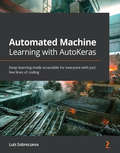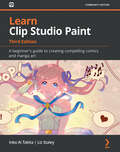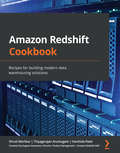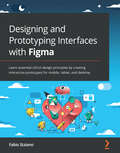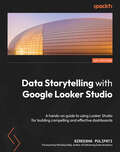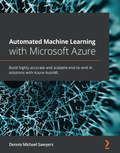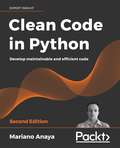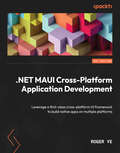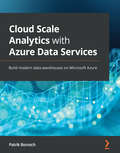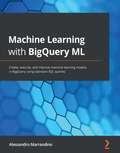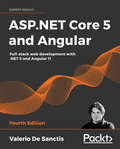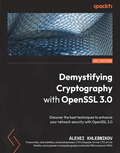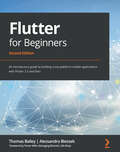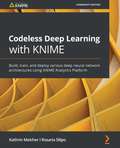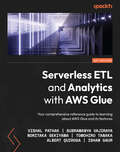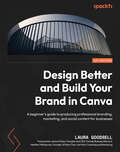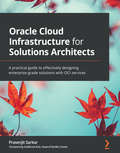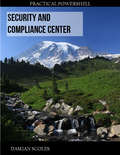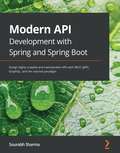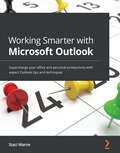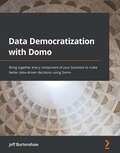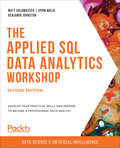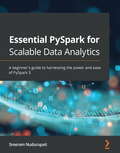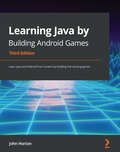- Table View
- List View
Automated Machine Learning with AutoKeras: Deep learning made accessible for everyone with just few lines of coding
by Luis SobrecuevaCreate better and easy-to-use deep learning models with AutoKerasKey FeaturesDesign and implement your own custom machine learning models using the features of AutoKerasLearn how to use AutoKeras for techniques such as classification, regression, and sentiment analysisGet familiar with advanced concepts as multi-modal, multi-task, and search space customizationBook DescriptionAutoKeras is an AutoML open-source software library that provides easy access to deep learning models. If you are looking to build deep learning model architectures and perform parameter tuning automatically using AutoKeras, then this book is for you. This book teaches you how to develop and use state-of-the-art AI algorithms in your projects. It begins with a high-level introduction to automated machine learning, explaining all the concepts required to get started with this machine learning approach. You will then learn how to use AutoKeras for image and text classification and regression. As you make progress, you'll discover how to use AutoKeras to perform sentiment analysis on documents. This book will also show you how to implement a custom model for topic classification with AutoKeras. Toward the end, you will explore advanced concepts of AutoKeras such as working with multi-modal data and multi-task, customizing the model with AutoModel, and visualizing experiment results using AutoKeras Extensions. By the end of this machine learning book, you will be able to confidently use AutoKeras to design your own custom machine learning models in your company.What you will learnSet up a deep learning workstation with TensorFlow and AutoKerasAutomate a machine learning pipeline with AutoKerasCreate and implement image and text classifiers and regressors using AutoKerasUse AutoKeras to perform sentiment analysis of a text, classifying it as negative or positiveLeverage AutoKeras to classify documents by topicsMake the most of AutoKeras by using its most powerful extensionsWho this book is forThis book is for machine learning and deep learning enthusiasts who want to apply automated ML techniques to their projects. Prior basic knowledge of Python programming and machine learning is expected to get the most out of this book.
Learn Clip Studio Paint: A beginner's guide to creating compelling comics and manga art, 3rd Edition
by Liz Staley Inko Ai TakitaDiscover the tools to tell your own manga story with Clip Studio Paint and develop your digital drawing skillsKey FeaturesA helpful guide to gain a clear understanding of Clip Studio Paint and create your own manga stories with key images printed in colorLearn to put CSP into practice by implementing it in real-world drawing scenariosDiscover how to apply digital drawing techniques to your creation using CSPBook DescriptionClip Studio Paint is a versatile digital painting program for creating manga and illustrations, helping artists expand their digital portfolio. This software is packed with tools that make panel laying, speech adding, toning, and editing much easier. This easy-to-follow guide is clearly divided into chapters covering drawing tools, interface customization, and using various visual effects so you can focus on specific techniques in detail one at a time.Learn Clip Studio Paint is a comprehensive introduction for those who are new to Clip Studio Paint that will have you up to speed in no time. You'll start by experiencing what it's like to create manga digitally and find new ways to shape your drawing. Next, using practical tips and rich visual references, the book shows you how to apply techniques to your creations, giving you the opportunity to expand your range of visual expression. As you advance, you'll explore how to create special effect brushes using an in-depth example, along with discovering how to color, blend, and edit your art digitally. Finally, you'll find out how to print, use the Clip Studio Paint Assets, and learn how to create unique and inspiring art that stands out from the rest.By the end of this Clip Studio Paint book, you'll have gained a clear understanding of its tools and be able to start telling your own manga story using your improved digital drawing skills.What you will learnExplore Clip Studio Paint and create your own manga storiesFamiliarize yourself with the CSP ecosystemUse Clip Studio Paint Pro's inking tools and find ways to customize your artExplore the flexibility of the brush engine in Clip Studio Paint ProUse palettes to generate colors between foreground and background colorsFind out alternative ways of coloring your manga art using black, white, and greyDiscover how to use layer blending to add textures to your imagesWho this book is forIf you're just starting out as a digital artist or want to switch to Clip Studio Paint from a different graphics software package, then this book is for you. Those with no prior knowledge of digital art or intermediate-level users looking to explore the unique features of Clip Studio Paint will also find this book useful.
Amazon Redshift Cookbook: Recipes for building modern data warehousing solutions
by Shruti Worlikar Thiyagarajan Arumugam Harshida Patel Eugene Kawamoto>pb/b/ph4/h4ulli/lili/lili/li/ulh4/h4p/pp/pp/ph4/h4ulli/lili/lili/lili/lili/lili/li/ulh4/h4p/p<
Designing and Prototyping Interfaces with Figma: Learn essential UX/UI design principles by creating interactive prototypes for mobile, tablet, and desktop
by Fabio StaianoDiscover user experience and user interface design best practices while mastering a wide array of tools across Figma and FigJam with this full-color guideKey FeaturesLearn the basics of user experience research, result organization, and analysis in FigJamCreate mockups, interactive animations, and high-fidelity prototypes using this platform-independent web application toolCollaborate with a team in real-time and create, share, and test your designsBook DescriptionA driving force of the design tools market, Figma makes it easy to work with classic design features while enabling unique innovations and opening up real-time collaboration possibilities. It comes as no surprise that many designers decide to switch from other tools to Figma.In this book, you'll be challenged to design a user interface for a responsive mobile application having researched and understood user needs. You'll become well-versed with the process in a step-by-step manner by exploring the theory first and gradually moving on to practice. You'll begin your learning journey by covering the basics of user experience research with FigJam and the process of creating a complete design using Figma tools such as Components, Variants, Auto Layout, and much more. You'll also learn how to prototype your design and explore the potential of community resources such as templates and plugins.By the end of this Figma book, you'll have a solid understanding of the user interface workflow, managing essential Figma tools, and organizing your workflow.What you will learnExplore FigJam and how to use it to collect data in the research phaseWireframe the future interface with shape tools and vectorsDefine grids, typography, colors, and effect styles that can be reused in your workGet to grips with Auto Layout and the constraints to create complex layoutsCreate flexible components using styles and variantsMake your user interface interactive with prototyping and smart animateShare your work with others by exporting assets and preparing development resourcesDiscover templates and plugins from the communityWho this book is forThis book is for aspiring UX/UI designers who want to get started with Figma as well as established designers who want to migrate to Figma from other design tools. This guide will take you through the entire process of creating a full-fledged prototype for a responsive interface using all the tools and features that Figma has to offer. As a result, this Figma design book is suitable for both UX and UI designers, product and graphic designers, and anyone who wants to explore the complete design process from scratch.
Data Storytelling with Google Looker Studio: A hands-on guide to using Looker Studio for building compelling and effective dashboards
by Nicholas Kelly Sireesha PulipatiApply data storytelling concepts and analytical thinking to create dashboards and reports in Looker Studio to aid data-driven decision makingKey FeaturesGain a solid understanding of data visualization principles and learn to apply them effectivelyGet to grips with the concepts and features of Looker Studio to create powerful data storiesExplore the end-to-end process of building dashboards with the help of practical examplesBook DescriptionPresenting data visually makes it easier for organizations and individuals to interpret and analyze information. Looker Studio is an easy-to-use, collaborative tool that enables you to transform your data into engaging visualizations. This allows you to build and share dashboards that help monitor key performance indicators, identify patterns, and generate insights to ultimately drive decisions and actions. Data Storytelling with Looker Studio begins by laying out the foundational design principles and guidelines that are essential to creating accurate, effective, and compelling data visualizations. Next, you'll delve into features and capabilities of Looker Studio – from basic to advanced – and explore their application with examples. The subsequent chapters walk you through building dashboards with a structured three-stage process called the 3D approach using real-world examples that'll help you understand the various design and implementation considerations. This approach involves determining the objectives and needs of the dashboard, designing its key components and layout, and developing each element of the dashboard. By the end of this book, you will have a solid understanding of the storytelling approach and be able to create data stories of your own using Looker Studio.What you will learnUnderstand what storytelling with data means, and explore its various formsDiscover the 3D approach to building dashboards – determine, design, and developTest common data visualization pitfalls and learn how to mitigate themGet up and running with Looker Studio and leverage it to explore and visualize dataExplore the advanced features of Looker Studio with examplesBecome well-versed in the step-by-step process of the 3D approach using practical examplesMeasure and monitor the usage patterns of your Looker Studio reportsWho this book is forIf you are a beginner or an aspiring data analyst looking to understand the core concepts of data visualization and want to use Looker Studio for creating effective dashboards, this book is for you. No specific prior knowledge is needed to understand the concepts present in this book. Experienced data analysts and business intelligence developers will also find this book useful as a detailed guide to using Looker Studio as well as a refresher of core dashboarding concepts.
Automated Machine Learning with Microsoft Azure: Build highly accurate and scalable end-to-end AI solutions with Azure AutoML
by Dennis Michael SawyersA practical, step-by-step guide to using Microsoft's AutoML technology on the Azure Machine Learning service for developers and data scientists working with the Python programming languageKey FeaturesCreate, deploy, productionalize, and scale automated machine learning solutions on Microsoft AzureImprove the accuracy of your ML models through automatic data featurization and model trainingIncrease productivity in your organization by using artificial intelligence to solve common problemsBook DescriptionAutomated Machine Learning with Microsoft Azure helps you to build high-performing, accurate machine learning models in record time. It allows anyone to easily harness the power of artificial intelligence and increase the productivity and profitability of your business. With a series of clicks on a guided user interface (GUI), novices and seasoned data scientists alike can train and deploy machine learning solutions to production with ease. This book will teach you how to use Azure AutoML with both the GUI as well as the AzureML Python software development kit (SDK) in a careful, step-by-step way. First, you'll learn how to prepare data, train models, and register them to your Azure Machine Learning workspace. You'll then discover how to take those models and use them to create both automated batch solutions using machine learning pipelines and real-time scoring solutions using Azure Kubernetes Service (AKS). Finally, you will be able to use AutoML on your own data to not only train regression, classification, and forecasting models but also use them to solve a wide variety of business problems. By the end of this Azure book, you'll be able to show your business partners exactly how your ML models are making predictions through automatically generated charts and graphs, earning their trust and respect.What you will learnUnderstand how to train classification, regression, and forecasting ML algorithms with Azure AutoMLPrepare data for Azure AutoML to ensure smooth model training and deploymentAdjust AutoML configuration settings to make your models as accurate as possibleDetermine when to use a batch-scoring solution versus a real-time scoring solutionProductionalize your AutoML solution with Azure Machine Learning pipelinesCreate real-time scoring solutions with AutoML and Azure Kubernetes ServiceDiscover how to quickly deliver value and earn business trust using AutoMLTrain a large number of AutoML models at once using the AzureML Python SDKWho this book is forData scientists, aspiring data scientists, machine learning engineers, or anyone interested in applying artificial intelligence or machine learning in their business will find this book useful. You need to have beginner-level knowledge of artificial intelligence and a technical background in computer science, statistics, or information technology before getting started with this machine learning book. Familiarity with Python will help you implement this book's more advanced features, but even data analysts and SQL experts will be able to train ML models after finishing this book.
Practical System programming for Rust developers: Build Fast And Secure Software For Linux/unix Systems With The Help Of Practical Examples
by Prabhu EshwarlaThis book is for developers with basic knowledge of Rust but little to no knowledge or experience of systems programming. System programmers who want to consider Rust as an alternative to C or C++ will also find this book useful.
Clean Code in Python: Develop maintainable and efficient code, 2nd Edition
by Mariano AnayaImprove your software engineering practices to tackle inefficiencies, errors, and other perils that emerge due to bad codeKey FeaturesEnhance your coding skills to increase efficiency as well as reflect the new features introduced in Python 3.9Understand how to apply microservices to your legacy systems by implementing practical techniquesLearn to implement the refactoring techniques and SOLID principles in PythonBook DescriptionThe Python language is immensely prevalent in numerous areas, such as software construction, systems administration, and data processing. Experienced professionals in every field face the challenges of disorganization, poor readability, and low testability as a result of unstructured code. With updated code and revised content aligned to the new features of Python 3.9, this second edition of Clean Code in Python will provide you with all the tools you need to overcome these obstacles and manage your projects successfully. The book begins by describing the basic elements of writing clean code and how it plays a key role in Python programming. You will learn about writing efficient and readable code using the Python standard library and best practices for software design. The book delves deeply into object-oriented programming in Python and shows you how to use objects with descriptors and generators. It will also show you the design principles of software testing and how to resolve problems by implementing software design patterns in your code. In the final chapter, we break down a monolithic application into a microservices based one starting from the code as the basis for a solid platform. By the end of this clean code book, you will be proficient in applying industry-approved coding practices to design clean, sustainable, and readable real-world Python code.What you will learnSet up a productive development environment by leveraging automatic toolsLeverage the magic methods in Python to write better code, abstracting complexity away and encapsulating detailsCreate advanced object-oriented designs using unique features of Python, such as descriptorsEliminate duplicated code by creating powerful abstractions using software engineering principles of object-oriented designCreate Python-specific solutions using decorators and descriptorsRefactor code effectively with the help of unit testsBuild the foundations for solid architecture with a clean code base as its cornerstoneWho this book is forThis book will appeal to team leads, software architects, and senior software engineers who want to learn Python coding techniques and work on their legacy systems to save cost and improve efficiency. The book assumes that you have a strong understanding of programming.
.NET MAUI Cross-Platform Application Development: Leverage a first-class cross-platform UI framework to build native apps on multiple platforms
by Roger YeBuild apps for Android, iOS, macOS, and Windows using Microsoft's .NET Multi-platform App UI and BlazorKey FeaturesGet familiar with Microsoft's UI toolkit to build amazing interfaces for iOS, Android, Windows, and macOSBuild a cross-platform password manager based on the famous Windows app, KeePassExplore .NET MAUI development and Hybrid app development using BlazorBook DescriptionAn evolution of Xamarin.Forms, .NET Multi-platform App UI (.NET MAUI) is a cross-platform framework for creating native mobile and desktop apps with C# and XAML. Using .NET MAUI, you can develop apps that'll run on Android, iOS, macOS, and Windows from a single shared code-base. This step-by-step guide provides a comprehensive introduction to those who are new to .NET MAUI that will have you up to speed with app development using .NET MAUI in no time.The book begins by showing you how to develop a cross-platform application using .NET MAUI and then helps you build an app throughout the chapters. You'll gain all the knowledge needed to create a cross-platform application for Android, iOS, the mac OS, and Windows from a single shared code-base using .NET MAUI. As you advance, you'll get to grips with the entire application development lifecycle, from design and implementation through to deployment to the app store through the development of a password manager app using KeePassLib. The concluding chapters will teach you how to integrate the latest frontend technology into your app through .NET MAUI Blazor.By the end of this book, you'll have learned how to develop your own cross-platform applications using .NET MAUI.What you will learnDiscover the latest features of .NET 6 that can be used in mobile and desktop app developmentFind out how to build cross-platform apps with .NET MAUI and BlazorImplement device-specific features using .NET MAUI EssentialsIntegrate third-party libraries and add your own device-specific featuresDiscover .NET class unit test using xUnit.net and Razor components unit test using bUnitDeploy apps in different app stores on mobile as well as desktopWho this book is forThis book is an entry-level .NET MAUI book for mobile developers interested in cross-platform application development with working experience of the .NET Core framework, as well as fresh or junior engineers who've just begun their career in mobile app development. Native application developers (desktop) or Xamarin developers who want to migrate to .NET MAUI will also benefit from this book. Basic knowledge of modern object-oriented programming language, such as C#, Java or Kotlin, is assumed.
Cloud Scale Analytics with Azure Data Services: Build modern data warehouses on Microsoft Azure
by Patrik BoroschA practical guide to implementing a scalable and fast state-of-the-art analytical data estateKey FeaturesStore and analyze data with enterprise-grade security and auditingPerform batch, streaming, and interactive analytics to optimize your big data solutions with easeDevelop and run parallel data processing programs using real-world enterprise scenariosBook DescriptionAzure Data Lake, the modern data warehouse architecture, and related data services on Azure enable organizations to build their own customized analytical platform to fit any analytical requirements in terms of volume, speed, and quality. This book is your guide to learning all the features and capabilities of Azure data services for storing, processing, and analyzing data (structured, unstructured, and semi-structured) of any size. You will explore key techniques for ingesting and storing data and perform batch, streaming, and interactive analytics. The book also shows you how to overcome various challenges and complexities relating to productivity and scaling. Next, you will be able to develop and run massive data workloads to perform different actions. Using a cloud-based big data-modern data warehouse-analytics setup, you will also be able to build secure, scalable data estates for enterprises. Finally, you will not only learn how to develop a data warehouse but also understand how to create enterprise-grade security and auditing big data programs. By the end of this Azure book, you will have learned how to develop a powerful and efficient analytical platform to meet enterprise needs.What you will learnImplement data governance with Azure servicesUse integrated monitoring in the Azure Portal and integrate Azure Data Lake Storage into the Azure MonitorExplore the serverless feature for ad-hoc data discovery, logical data warehousing, and data wranglingImplement networking with Synapse Analytics and Spark poolsCreate and run Spark jobs with Databricks clustersImplement streaming using Azure Functions, a serverless runtime environment on AzureExplore the predefined ML services in Azure and use them in your appWho this book is forThis book is for data architects, ETL developers, or anyone who wants to get well-versed with Azure data services to implement an analytical data estate for their enterprise. The book will also appeal to data scientists and data analysts who want to explore all the capabilities of Azure data services, which can be used to store, process, and analyze any kind of data. A beginner-level understanding of data analysis and streaming will be required.
Machine Learning with BigQuery ML: Create, execute, and improve machine learning models in BigQuery using standard SQL queries
by Alessandro MarrandinoManage different business scenarios with the right machine learning technique using Google's highly scalable BigQuery MLKey FeaturesGain a clear understanding of AI and machine learning services on GCP, learn when to use these, and find out how to integrate them with BigQuery MLLeverage SQL syntax to train, evaluate, test, and use ML modelsDiscover how BigQuery works and understand the capabilities of BigQuery ML using examplesBook DescriptionBigQuery ML enables you to easily build machine learning (ML) models with SQL without much coding. This book will help you to accelerate the development and deployment of ML models with BigQuery ML. The book starts with a quick overview of Google Cloud and BigQuery architecture. You'll then learn how to configure a Google Cloud project, understand the architectural components and capabilities of BigQuery, and find out how to build ML models with BigQuery ML. The book teaches you how to use ML using SQL on BigQuery. You'll analyze the key phases of a ML model's lifecycle and get to grips with the SQL statements used to train, evaluate, test, and use a model. As you advance, you'll build a series of use cases by applying different ML techniques such as linear regression, binary and multiclass logistic regression, k-means, ARIMA time series, deep neural networks, and XGBoost using practical use cases. Moving on, you'll cover matrix factorization and deep neural networks using BigQuery ML's capabilities. Finally, you'll explore the integration of BigQuery ML with other Google Cloud Platform components such as AI Platform Notebooks and TensorFlow along with discovering best practices and tips and tricks for hyperparameter tuning and performance enhancement. By the end of this BigQuery book, you'll be able to build and evaluate your own ML models with BigQuery ML.What you will learnDiscover how to prepare datasets to build an effective ML modelForecast business KPIs by leveraging various ML models and BigQuery MLBuild and train a recommendation engine to suggest the best products for your customers using BigQuery MLDevelop, train, and share a BigQuery ML model from previous parts with AI Platform NotebooksFind out how to invoke a trained TensorFlow model directly from BigQueryGet to grips with BigQuery ML best practices to maximize your ML performanceWho this book is forThis book is for data scientists, data analysts, data engineers, and anyone looking to get started with Google's BigQuery ML. You'll also find this book useful if you want to accelerate the development of ML models or if you are a business user who wants to apply ML in an easy way using SQL. Basic knowledge of BigQuery and SQL is required.
ASP.NET Core 5 and Angular: Full-stack web development with .NET 5 and Angular 11, 4th Edition
by Valerio De SanctisBuild a simple, yet fully functional modern web application using .NET 5, Entity Framework Core, and Angular 11Key FeaturesComprehensively updated with the latest features and additions in ASP.NET Core 5 and Angular 11Design, build, and deploy a Single Page Application or Progressive Web App with ASP.NET Core and AngularAdopt a full stack approach to handle data management, Web APIs, application design, testing, SEO, security, and deploymentBook DescriptionLearning full-stack development calls for knowledge of both front-end and back-end web development. ASP.NET Core 5 and Angular, Fourth Edition will get you started with Angular to build robust web applications as well as the ASP.NET Core 5 and Web API Controllers to implement API calls and server-side routing in the back-end. This fully revised edition includes a side-by-side comparison of the Visual Studio Angular app versus NG App and coverage of the Angular routing module. You will learn how to build a data model with Entity Framework Core, alongside utilizing the Entity Core Fluent API and EntityTypeConfiguration class. As you progress, you will learn how to handle user input with Angular reactive forms and front-end and back-end validators for maximum effect. You will later explore the advanced debugging and unit testing features provided by xUnit.net (.NET 5) and Jasmine, as well as Karma for Angular. Further, you will dive deep into progressive web applications (PWAs), learning about their technical requirements, testing, and converting SWAs to PWAs. Finally, you will learn how to deploy apps on Windows, Linux, and Azure using IIS, Kestrel, and nginx. By the end of this book, you will be equipped with the skills you need to create, debug, and deploy efficient web applications using ASP.NET Core and Angular.What you will learnImplement a Web API interface with ASP.NET Core and consume it with Angular using RxJS ObservablesSet up a SQL database server using a local instance or a cloud data storePerform C# and TypeScript debugging using Visual Studio 2019Create TDD and BDD unit tests using xUnit, Jasmine, and KarmaExplore the EF Core Fluent API and EntityTypeConfiguration classesPerform DBMS structured logging using third-party providers such as SeriLogDeploy a Web application to Windows and Linux web servers, or to cloud-based PaaS solutions such as Azure App ServiceWho this book is forThis book is for experienced ASP.NET developers who already possess some experience with ASP.NET Core and Angular and are looking to learn how to use them together to create production-ready Single Page Applications (SPAs) or Progressive Web Applications (PWAs).However, the fully documented code samples (also available on GitHub) and the step-by-step implementation tutorials make this book easy-to-understand - even for beginners.
Demystifying Cryptography with OpenSSL 3.0: Discover the best techniques to enhance your network security with OpenSSL 3.0
by Alexei Khlebnikov Jarle AdolfsenUse OpenSSL to add security features to your application, including cryptographically strong symmetric and asymmetric encryption, digital signatures, SSL/TLS connectivity, and PKI handlingKey FeaturesSecure your applications against common network security threats using OpenSSLGet to grips with the latest version of OpenSSL, its new features, and advantagesLearn about PKI, cryptography, certificate authorities, and more using real-world examplesBook DescriptionSecurity and networking are essential features of software today. The modern internet is full of worms, Trojan horses, men-in-the-middle, and other threats. This is why maintaining security is more important than ever.OpenSSL is one of the most widely used and essential open source projects on the internet for this purpose. If you are a software developer, system administrator, network security engineer, or DevOps specialist, you've probably stumbled upon this toolset in the past – but how do you make the most out of it? With the help of this book, you will learn the most important features of OpenSSL, and gain insight into its full potential.This book contains step-by-step explanations of essential cryptography and network security concepts, as well as practical examples illustrating the usage of those concepts. You'll start by learning the basics, such as how to perform symmetric encryption and calculate message digests. Next, you will discover more about cryptography: MAC and HMAC, public and private keys, and digital signatures. As you progress, you will explore best practices for using X.509 certificates, public key infrastructure, and TLS connections.By the end of this book, you'll be able to use the most popular features of OpenSSL, allowing you to implement cryptography and TLS in your applications and network infrastructure.What you will learnUnderstand how to use symmetric cryptographyGet to grips with message digests, MAC, and HMACDiscover asymmetric cryptography and digital signaturesFocus on how to apply and use X.509 certificatesDive into TLS and its proper usageManage advanced and special usages of TLSFind out how to run a mini certificate authority for your organizationWho this book is forThis book is for software developers, system administrators, DevOps specialists, network security engineers, and analysts, or anyone who wants to keep their applications and infrastructure secure. Software developers will learn how to use the OpenSSL library to empower their software with cryptography and TLS. DevOps professionals and sysadmins will learn how to work with cryptographic keys and certificates on the command line, and how to set up a mini-CA for their organization. A basic understanding of security and networking is required.
Flutter for Beginners: An introductory guide to building cross-platform mobile applications with Flutter 2.5 and Dart, 2nd Edition
by Alessandro Biessek Thomas Bailey Trevor WillsDevelop the real-world experience you need to build and launch your own Flutter apps with this full-color guideKey FeaturesGet up to speed with the basics of Dart programming and delve into Flutter developmentLearn about Flutter widgets, plugins, and animations to create a high-quality app user experiencePackage and deploy your Flutter apps to achieve native-like performanceBook DescriptionThere have been many attempts at creating frameworks that are truly cross-platform, but most struggle to create a native-like experience at high performance levels. Flutter achieves this with an elegant design and a wealth of third-party plugins, making it the future of mobile app development. If you are a mobile developer who wants to create rich and expressive native apps with the latest Google Flutter framework, this book is for you.This book will guide you through developing your first app from scratch all the way to production release. Starting with the setup of your development environment, you'll learn about your app's UI design and responding to user input via Flutter widgets, manage app navigation and screen transitions, and create widget animations. You'll then explore the rich set of third party-plugins, including Firebase and Google Maps, and get to grips with testing and debugging. Finally, you'll get up to speed with releasing your app to mobile stores and the web.By the end of this Flutter book, you'll have gained the confidence to create, edit, test, and release a full Flutter app on your own.What you will learnExplore the core concepts of the Flutter framework and how it is used for cross-platform developmentUnderstand the fundamentals of the Dart programming languageWork with Flutter widgets and learn the concepts of stateful and stateless widgetsAdd animation to your app using animated widgets and advanced animations techniquesMaster the complete development lifecycle, including testing and debuggingInvestigate the app release process to both mobile stores and the webWho this book is forThis book is for developers looking to learn Google's revolutionary framework Flutter from scratch. No prior knowledge of Flutter or Dart is required.
Codeless Deep Learning with KNIME: Build, Train, And Deploy Various Deep Neural Network Architectures Using Knime Analytics Platform
by Rosaria Silipo Kathrin MelcherThis book is for data analysts, data scientists, and deep learning developers who are not well versed with Python but want to learn how to use KNIME GUI to build, train, test, and deploy neural networks with different architectures. The practical implementations shown in the book do not require coding or any knowledge of dedicated scripts, allowing you to quickly translate theoretical concepts into practical applications. No previous knowledge of KNIME is required.
Serverless ETL and Analytics with AWS Glue: Your comprehensive reference guide to learning about AWS Glue and its features
by Vishal Pathak Subramanya Vajiraya Noritaka Sekiyama Tomohiro Tanaka Albert QuirogaBuild efficient data lakes that can scale to virtually unlimited size using AWS GlueKey FeaturesLearn to work with AWS Glue to overcome typical implementation challenges in data lakesCreate and manage serverless ETL pipelines that can scale to manage big dataWritten by AWS Glue community members, this practical guide shows you how to implement AWS Glue in no timeBook DescriptionOrganizations these days have gravitated toward services such as AWS Glue that undertake undifferentiated heavy lifting and provide serverless Spark, enabling you to create and manage data lakes in a serverless fashion. This guide shows you how AWS Glue can be used to solve real-world problems along with helping you learn about data processing, data integration, and building data lakes.Beginning with AWS Glue basics, this book teaches you how to perform various aspects of data analysis such as ad hoc queries, data visualization, and real-time analysis using this service. It also provides a walk-through of CI/CD for AWS Glue and how to shift left on quality using automated regression tests. You'll find out how data security aspects such as access control, encryption, auditing, and networking are implemented, as well as getting to grips with useful techniques such as picking the right file format, compression, partitioning, and bucketing. As you advance, you'll discover AWS Glue features such as crawlers, Lake Formation, governed tables, lineage, DataBrew, Glue Studio, and custom connectors. The concluding chapters help you to understand various performance tuning, troubleshooting, and monitoring options.By the end of this AWS book, you'll be able to create, manage, troubleshoot, and deploy ETL pipelines using AWS Glue.What you will learnApply various AWS Glue features to manage and create data lakesUse Glue DataBrew and Glue Studio for data preparationOptimize data layout in cloud storage to accelerate analytics workloadsManage metadata including database, table, and schema definitionsSecure your data during access control, encryption, auditing, and networkingMonitor AWS Glue jobs to detect delays and loss of dataIntegrate Spark ML and SageMaker with AWS Glue to create machine learning modelsWho this book is forThis book is for ETL developers, data engineers, and data analysts who want to understand how AWS Glue can help you solve your business problems. Basic knowledge of AWS data services is assumed.
Design Better and Build Your Brand in Canva: A beginner's guide to producing professional branding, marketing, and social content for businesses
by Laura Goodsell Janine Friston Heather PalfreymanDiscover everything you need to get started with Canva, create a brand, and easily design professional-looking graphics to go from zero to pro in no timeKey FeaturesOrganize your business designs using folders and learn to schedule social media content in Canva's own content plannerLearn to create presentations, as well as video and animated social media postsDiscover the features of Canva to help you save time, including the brand kit, quick create and templatesBook DescriptionIf you're constantly frustrated by how long it takes to create a design in Canva, then you've come to the right place. This book will get you up and running quickly with creating professional branded graphics in Canva. You'll learn how to set up a Canva account, both free and pro and create a brand kit while understanding the importance of branding. Next, you'll discover all the features and tools as well as how to put everything together to build a brand you love and graphics that work for your business. As you progress, the chapters will show you how to organize your account, create presentations, use videos and animation within your marketing materials and more. By the end of this book, you'll have a solid understanding of what Canva is and what it does and be able to confidently and easily create a branded design from scratch.What you will learnUnderstand the fundamental capabilities and features of CanvaCreate a brand kit and understand what makes a good brandDevelop effective graphics to aid in increasing visibility on social media platformsFollow step-by-step tutorials to create stunning designsCreate a branded logo and learn about trademark and copyright guidelinesDiscover a world of color combinations, contrasts, and meanings for your brandExplore the fundamental design principlesUse videos, animation, and sounds in social graphics for your designsWho this book is forThis book is for aspiring designers, social media managers, VAs, service-based businesses and solopreneurs with basic experience in Canva, who are looking to advance in a new skill, while creating their brand and perfecting their social and marketing materials on a budget. A basic understanding of Canva, including setting up a free Canva account, creating a basic design using a template, adding images and text boxes and changing the color of fonts will be helpful but not essential.
Oracle Cloud Infrastructure for Solutions Architects: A practical guide to effectively designing enterprise-grade solutions with OCI services
by Prasenjit Sarkar Guillermo RuizDevelop enterprise architect skills by building secure, highly available, and cost-effective solutions with Oracle Functions, Terraform, and the Oracle Cloud VMware SolutionKey FeaturesExplore Oracle's Gen 2.0 Cloud infrastructure and its high-performance computing capabilitiesUnderstand hybrid cloud capabilities and learn to migrate apps from on-premises VMware clusters to OCILearn to create Kubernetes clusters and run containerized applications on Oracle's Container EngineBook DescriptionOracle Cloud Infrastructure (OCI) is a set of complementary cloud services that enables you to build and run a wide range of applications and services in a highly available hosted environment. This book is a fast-paced practical guide that will help you develop the capabilities to leverage OCI services and effectively manage your cloud infrastructure. Oracle Cloud Infrastructure for Solutions Architects begins by helping you get to grips with the fundamentals of Oracle Cloud Infrastructure, and moves on to cover the building blocks of the layers of Infrastructure as a Service (IaaS), such as Identity and Access Management (IAM), compute, storage, network, and database. As you advance, you'll delve into the development aspects of OCI, where you'll learn to build cloud-native applications and perform operations on OCI resources as well as use the CLI, API, and SDK. Finally, you'll explore the capabilities of building an Oracle hybrid cloud infrastructure. By the end of this book, you'll have learned how to leverage the OCI and gained a solid understanding of the persona of an architect as well as a developer's perspective.What you will learnBecome well-versed with the building blocks of OCI Gen 2.0 CloudControl access to your cloud resources using IAM componentsManage and operate various compute instancesTune and configure various storage options for your appsDevelop applications on OCI using OCI Registry (OCIR), Cloud Shell, OCI Container Engine for Kubernetes (OKE), and Service MeshDiscover ways to use object-relational mapping (ORM) to create infrastructure blocks using Terraform codeWho this book is forThis book is for cloud architects, cloud developers, and DevSecOps engineers who want to learn how to architect and develop on Oracle Cloud Infrastructure by leveraging a wide range of OCI IAAS capabilities. Working knowledge of Linux, exposure to basic programming, and a basic understanding of networking concepts are needed to get the most out of this book.
Practical PowerShell Security and Compliance Center: Get to grips with effectively managing the Security and Compliance Center with PowerShell, 2nd Edition
by Damian ScolesLearn all the latest practices to build and enhance your PowerShell scripts and manage the Security and Compliance Center easily and efficiently Key Features Gather the latest information and new cmdlets to get started with PowerShell Discover innovative ways to construct useful scripts Learn how to manage SCC with PowerShell through real-world scenarios Book Description PowerShell is an integral part of Office 365. This updated edition shares tips, tricks, new cmdlets, and best practices for using PowerShell with the Security and Compliance Center. The book starts by covering the basic tools of PowerShell, such as PowerShell ISE and PowerShell repositories, and then goes on to teach you how to connect to the SCC using multi-factor authentication. You will manage role groups to layer security, before exploring the importance of information barriers. As you progress, you will orchestrate insider risk policies to protect your organization from malicious users with access to sensitive data. Next, the book will show you how to manage various devices using tenant policies and device access rules. Later chapters will delve into various reporting methods and explore options for troubleshooting scripts and best practices to produce better scripts. The book concludes with an overview of Microsoft Secure Score to help you measure your organization's security posture. By the end of this book, you'll have the latest information and new cmdlets to confidently manage the Security and Compliance Center (SCC) with PowerShell. What you will learn Enhance the script, test it, and move it into production Make your PowerShell scripts more usable and accessible Study directory synchronization and its applications Explore layers of security that prevent unauthorized access Use PowerShell to implement Data Loss Prevention (DLP) Understand compliance and how it can be managed with PowerShell Who this book is for If you are already managing Exchange and have some PowerShell experience, then this book is for you. Professionals who want to gain more proficiency in PowerShell but are unsure of how to approach it will also find this book useful. To get the most out of this book, you must have sufficient experience of working in PowerShell as the book is not a beginner's guide to PowerShell.
Modern API Development with Spring and Spring Boot: Design highly scalable and maintainable APIs with REST, gRPC, GraphQL, and the reactive paradigm
by Sourabh SharmaA developer's guide to designing, testing, and securing production-ready modern APIs with the help of practical ideas to improve your application's functionalityKey FeaturesBuild resilient software for your enterprises and customers by understanding the complete API development life cycleOvercome the challenges of traditional API design by adapting to a new and evolving culture of modern API developmentUse Spring and Spring Boot to develop future-proof scalable APIsBook DescriptionThe philosophy of API development has evolved over the years to serve the modern needs of enterprise architecture, and developers need to know how to adapt to these modern API design principles. Apps are now developed with APIs that enable ease of integration for the cloud environment and distributed systems. With this Spring book, you'll discover various kinds of production-ready API implementation using REST APIs and explore async using the reactive paradigm, gRPC, and GraphQL. You'll learn how to design evolving REST-based APIs supported by HATEOAS and ETAGs and develop reactive, async, non-blocking APIs. After that, you'll see how to secure REST APIs using Spring Security and find out how the APIs that you develop are consumed by the app's UI. The book then takes you through the process of testing, deploying, logging, and monitoring your APIs. You'll also explore API development using gRPC and GraphQL and design modern scalable architecture with microservices. The book helps you gain practical knowledge of modern API implementation using a sample e-commerce app. By the end of this Spring book, you'll be able to develop, test, and deploy highly scalable, maintainable, and developer-friendly APIs to help your customers to transform their business.What you will learnUnderstand RESTful API development, its design paradigm, and its best practicesBecome well versed in Spring's core components for implementing RESTful web servicesImplement reactive APIs and explore async API developmentApply Spring Security for authentication using JWT and authorization of requestsDevelop a React-based UI to consume APIsImplement gRPC inter-service communicationDesign GraphQL-based APIs by understanding workflows and toolingGain insights into how you can secure, test, monitor, and deploy your APIsWho this book is forThis book is for inexperienced Java programmers, comp science, or coding boot camp graduates who have knowledge of basic programming constructs, data structures, and algorithms in Java but lack the practical web development skills necessary to start working as a developer. Professionals who've recently joined a startup or a company and are tasked with creating real-world web APIs and services will also find this book helpful. This book is also a good resource for Java developers who are looking for a career move into web development to get started with the basics of web service development.
Working Smarter with Microsoft Outlook: Supercharge your office and personal productivity with expert Outlook tips and techniques
by Staci WarneWritten by a Microsoft Office Master Instructor, this book helps you transform into a productivity ninja by adopting highly efficient ways of managing Outlook in your daily lifeKey FeaturesLearn smart ways to customize Outlook for a highly productive daily routineAutomate mundane tasks using powerful tools such as Quick Steps and Mail Merge combined with Power AutomateCreate a cohesive environment and communication channels within your teams through information sharing using OutlookBook DescriptionMillions of users across the globe spend their working hours using Microsoft Outlook to manage tasks, schedules, emails, and more. Post-pandemic, many organizations have started adopting remote working, and the need to stay productive in workspace collaboration has been increasing.Working Smarter with Microsoft Outlook takes you through smart techniques, tips, and productivity hacks that will help you become an expert Outlook user. This book brings together everything you need to know about automating your daily repetitive tasks. You'll gain the skills necessary for working with calendars, contacts, notes, and tasks, and using them to collaborate with Microsoft SharePoint, OneNote, and many other services. You'll learn how to use powerful tools such as Quick Steps, customized Rules, and Mail Merge with Power Automate for added functionality. Later, the book covers how to use Outlook for sharing information between Microsoft Exchange and cloud services. Toward the concluding chapters, you'll get an introduction to Outlook programming by creating macros and seeing how you can integrate it within Outlook.By the end of this Microsoft Outlook book, you'll be able to use Outlook and its features and capabilities efficiently to enhance your workspace collaboration and time management.What you will learnTailor the Outlook environment to the specific needs of your working environmentUnderstand tips and tricks for setting up and managing appointments and eventsCustomize the content getting printed in Outlook calendarsExplore best practices and steps for sharing an Outlook workspace with coworkersUnderstand how Outlook can handle RSS feedsImplement the Rules section that will be beneficial for daily routinesCreate a time-management system that you can implement to organize and control your inboxWho this book is forThis book is for Microsoft Outlook users and business professionals who work with Microsoft Outlook daily and are interested in learning tips and tricks for exploring its full potential.
Data Democratization with Domo: Bring together every component of your business to make better data-driven decisions using Domo
by Jeff BurtenshawOvercome data challenges at record speed and cloud-scale that optimize businesses by transforming raw data into dashboards and apps which democratize data consumption, supercharging results with the cloud-based solution, DomoKey FeaturesAcquire data and automate data pipelines quickly for any data volume, variety, and velocityPresent relevant stories in dashboards and custom apps that drive favorable outcomes using DomoShare information securely and govern content including Domo content embedded in other toolsBook DescriptionDomo is a power-packed business intelligence (BI) platform that empowers organizations to track, analyze, and activate data in record time at cloud scale and performance. Data Democratization with Domo begins with an overview of the Domo ecosystem. You'll learn how to get data into the cloud with Domo data connectors and Workbench; profile datasets; use Magic ETL to transform data; work with in-memory data sculpting tools (Data Views and Beast Modes); create, edit, and link card visualizations; and create card drill paths using Domo Analyzer. Next, you'll discover options to distribute content with real-time updates using Domo Embed and digital wallboards. As you advance, you'll understand how to use alerts and webhooks to drive automated actions. You'll also build and deploy a custom app to the Domo Appstore and find out how to code Python apps, use Jupyter Notebooks, and insert R custom models. Furthermore, you'll learn how to use Auto ML to automatically evaluate dozens of models for the best fit using SageMaker and produce a predictive model as well as use Python and the Domo Command Line Interface tool to extend Domo. Finally, you'll learn how to govern and secure the entire Domo platform. By the end of this book, you'll have gained the skills you need to become a successful Domo master.What you will learnUnderstand the Domo cloud data warehouse architecture and platformAcquire data with Connectors, Workbench, and Federated QueriesSculpt data using no-code Magic ETL, Data Views, and Beast ModesProfile data with the Data Dictionary, Data Profile, and Usage toolsUse a storytelling pattern to create dashboards with Domo StoriesCreate, share, and monitor custom alerts activated using webhooksCreate custom Domo apps, use the Domo CLI, and code with the Python APIAutomate model operations with Python programming and R scriptingWho this book is forThis book is for BI developers, ETL developers, and Domo users looking for a comprehensive, end-to-end guide to exploring Domo features for BI. Chief data officers, data strategists, architects, and BI managers interested in a new paradigm for integrated cloud data storage, data transformation, storytelling, content distribution, custom app development, governance, and security will find this book useful. Business analysts seeking new ways to tell relevant stories to shape business performance will also benefit from this book. A basic understanding of Domo will be helpful.
The Applied SQL Data Analytics Workshop: Develop your practical skills and prepare to become a professional data analyst, 2nd Edition
by Benjamin Johnston Upom Malik Matt GoldwasserTake a step-by-step approach to learning SQL data analysis in this interactive workshop that uses fun exercises and activities to make learning data analytics for beginners easy and approachable. Key Features Explore ways to use SQL for data analytics and gain key insights from your data Study advanced analytics, such as geospatial and text analytics Discover ways to integrate your SQL pipelines with other analytics technologies Book Description Every day, businesses operate around the clock and a huge amount of data is generated at a rapid pace. Hidden in this data are key patterns and behaviors that can help you and your business understand your customers at a deep, fundamental level. Are you ready to enter the exciting world of data analytics and unlock these useful insights? Written by a team of expert data scientists who have used their data analytics skills to transform businesses of all shapes and sizes, The Applied SQL Data Analytics Workshop is a great way to get started with data analysis, showing you how to effectively sieve and process information from raw data, even without any prior experience. The book begins by showing you how to form hypotheses and generate descriptive statistics that can provide key insights into your existing data. As you progress, you'll learn how to write SQL queries to aggregate, calculate and combine SQL data from sources outside of your current dataset. You'll also discover how to work with different data types, like JSON. By exploring advanced techniques, such as geospatial analysis and text analysis, you'll finally be able to understand your business at a deeper level. Finally, the book lets you in on the secret to getting information faster and more effectively by using advanced techniques like profiling and automation. By the end of The Applied SQL Data Analytics Workshop, you'll have the skills you need to start identifying patterns and unlocking insights in your own data. You will be capable of looking and assessing data with the critical eye of a skilled data analyst. What you will learn Understand what data analytics is and why it is important Experiment with data analytics using basic and advanced queries Interpret data through descriptive statistics and aggregate functions Export data from external sources using powerful SQL queries Work with and manipulate data using SQL joins and constraints Speed up your data analysis workflow by automating tasks and optimizing queries Who this book is for If you are a database engineer who is looking to transition into analytics or someone who knows SQL basics but doesn't know how to use it to create business insights, then this book is for you.
Essential PySpark for Scalable Data Analytics: A beginner's guide to harnessing the power and ease of PySpark 3
by Sreeram NudurupatiGet started with distributed computing using PySpark, a single unified framework to solve end-to-end data analytics at scaleKey FeaturesDiscover how to convert huge amounts of raw data into meaningful and actionable insightsUse Spark's unified analytics engine for end-to-end analytics, from data preparation to predictive analyticsPerform data ingestion, cleansing, and integration for ML, data analytics, and data visualizationBook DescriptionApache Spark is a unified data analytics engine designed to process huge volumes of data quickly and efficiently. PySpark is Apache Spark's Python language API, which offers Python developers an easy-to-use scalable data analytics framework. Essential PySpark for Scalable Data Analytics starts by exploring the distributed computing paradigm and provides a high-level overview of Apache Spark. You'll begin your analytics journey with the data engineering process, learning how to perform data ingestion, cleansing, and integration at scale. This book helps you build real-time analytics pipelines that help you gain insights faster. You'll then discover methods for building cloud-based data lakes, and explore Delta Lake, which brings reliability to data lakes. The book also covers Data Lakehouse, an emerging paradigm, which combines the structure and performance of a data warehouse with the scalability of cloud-based data lakes. Later, you'll perform scalable data science and machine learning tasks using PySpark, such as data preparation, feature engineering, and model training and productionization. Finally, you'll learn ways to scale out standard Python ML libraries along with a new pandas API on top of PySpark called Koalas. By the end of this PySpark book, you'll be able to harness the power of PySpark to solve business problems.What you will learnUnderstand the role of distributed computing in the world of big dataGain an appreciation for Apache Spark as the de facto go-to for big data processingScale out your data analytics process using Apache SparkBuild data pipelines using data lakes, and perform data visualization with PySpark and Spark SQLLeverage the cloud to build truly scalable and real-time data analytics applicationsExplore the applications of data science and scalable machine learning with PySparkIntegrate your clean and curated data with BI and SQL analysis toolsWho this book is forThis book is for practicing data engineers, data scientists, data analysts, and data enthusiasts who are already using data analytics to explore distributed and scalable data analytics. Basic to intermediate knowledge of the disciplines of data engineering, data science, and SQL analytics is expected. General proficiency in using any programming language, especially Python, and working knowledge of performing data analytics using frameworks such as pandas and SQL will help you to get the most out of this book.
Learning Java by Building Android Games: Learn Java and Android from scratch by building five exciting games, 3rd Edition
by John HortonGet ready to learn Java the fun way by developing games for the Android platform with this new and updated third editionKey FeaturesLearn Java, Android, and object-oriented programming from scratchFind out how to build games including Sub Hunter, Retro Pong, Bullet Hell, Classic Snake, and Scrolling ShootersCreate and design your own games by learning all the concepts that a game developer must knowBook DescriptionAndroid is one of the most popular mobile operating systems today. It uses the most popular programming language, Java, as one of the primary languages for building apps of all types. Unlike most other Android books, this book doesn't assume that you have any prior knowledge of Java programming, instead helps you get started with building Android games as a beginner. This new, improved, and updated third edition of Learning Java by Building Android Games helps you to build Android games from scratch. Once you've got to grips with the fundamentals, the difficulty level increases steadily as you explore key Java topics, such as variables, loops, methods, object-oriented programming (OOP), and design patterns while working with up-to-date code and supporting examples. At each stage, you'll be able to test your understanding by implementing the concepts that you've learned to develop a game. Toward the end, you'll build games such as Sub Hunter, Retro Pong, Bullet Hell, Classic Snake, and Scrolling Shooter. By the end of this Java book, you'll not only have a solid understanding of Java and Android basics but will also have developed five cool games for the Android platform.What you will learnSet up a game development environment in Android StudioRespond to a player's touch and program intelligent enemies who can challenge the player in different waysExplore collision detection, sprite sheets animation, simple tracking and following, AI, parallax backgrounds, and particle explosionsAnimate objects at 60 FPS and manage multiple independent objects using OOPWork with design patterns such as OOP, singleton, strategy, and entity-componentWork with the Android API, the SoundPool API, Paint, Canvas, Bitmap classes, and detect version numbersWho this book is forLearning Java by Building Android Games is for anyone who is new to Java, Android, or game programming and wants to develop Android games. The book will also serve as a refresher for those who already have experience using Java on Android or any other platform but are new to game development.
